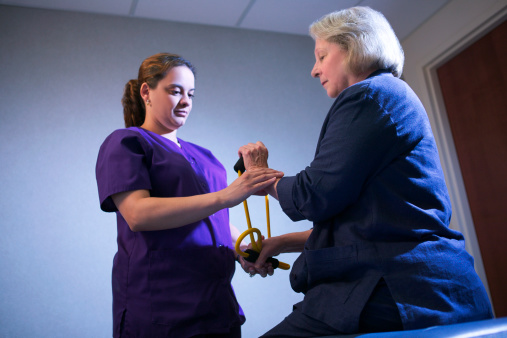

Occupational therapy assistants (OTAs) and Certified Occupational Therapy Assistants (COTAs) specialize in the delivery and development of treatments for children and adults with injuries, illnesses, or disabilities. Occupational therapy assistants work under the direct supervision of an occupational therapist and help patients learn techniques to improve activities of daily living like brushing their teeth, dressing, grooming and hygiene, feeding themselves and many other activities.
OTA jobs are expected to increase by 43% by the year 2020—that’s a faster than average growth rate and follows the expected surge in healthcare related jobs. OTAs and COTAs both perform the same job duties but COTAs have taken and passed a national certification exam that demonstrates proficiency in the field and could mean slightly higher pay. All OTAs must take the exam and be certified to practice in the United States.
There are a variety of patients who may benefit from occupational therapy. From small children to elderly patients, conditions like mental illness, birth defects, traumatic injuries, head trauma, stroke, and more can make it difficult to live and function independently. Occupational therapists and their assistants teach patients techniques and provide them with assistive devices to manage day-to-day tasks with as much independence as possible.
OTAs also carry out a variety of administrative duties in addition to following the treatment plan created by the occupational therapist. These duties may include assisting patients and families with paperwork or insurance forms, answering phone calls and preparing treatment areas and equipment before therapy sessions.
A great OTA will have several solid qualities. Good communication skills are essential. Because most of the OTA’s patients will have impairments, he or she must be a good listener and speak clearly so the patient can follow instructions without frustration. Sensitivity, compassion, and patience are also important. Patient progress may be slow or they may be uncooperative—the OTA must be able to handle these situations without becoming frustrated. This field may also require a significant amount of bending, stretching or lifting, so the OTA needs to be in good physical condition.
Is a career as an OTA right for you? Here are a few positives and negatives about the career for you to consider before moving forward.
To become an OTA you will need to complete high school or have a GED, then enroll in an accredited occupational therapy assistant program. You can learn more about what programs are available by visiting the National Board for Certification in Occupational Therapy. Most states have four or five programs, but some only have one or two so make sure to ask before you enroll if the program you are considering is accredited or do some online research. Accredited programs have met national standards of quality to educate students in their field and you must graduate from an accredited program in order to take the certification exam later.
After graduation, you will need to register for your certification examination. In order to apply for work and care for patients, you must pass this test. The COTA exam costs around $600 to complete and can be taken soon after college graduation. Students will study for the exam on their own then register for the computer test online. The test is given at local testing centers across the country. A paper version is available, but costs more.
The Bureau of Labor Statistics reports that average pay for COTAs is $51,000 per year. The highest paying jobs were with home health agencies followed by nursing facilities (long term care) and offices where specialty therapists work together. This may include audiologists, speech pathologists and physical therapists. State, local, and private schools paid the lowest.
Occupational therapy and physical therapy are often confused, and are a great comparison. Both OTAs and PTAs assist the lead therapist, but instead of providing patients with daily activity help, he or she carries out activities just for physical wellness. Physical therapy is a the direct application of exercises, strength, and balance training that addresses only the needs of the bones, muscles and other supporting structures of the body. PTAs carry out instructions from the physical therapist and may oversee a patient’s progress in much the same way as an OTA. Pay rates are similar for both fields.


Occupational therapy assistants can benefit from travel opportunities within the healthcare field. Travel careers are best for OTAs who have been working for several years and are confident working with little guidance. Of course, you will always have an occupational therapist present but a solid skill set should not be overlooked. Travel jobs offer OTAs the chance to see the country and work in some of the best medical facilities available. He or she will also enjoy higher pay for traveling plus stipends for housing, travel expenses and much more.
By Rachel Ballard RNC, BSN
 Rachel Ballard
Rachel Ballard
Rachel Ballard is a certified registered nurse and owner of the medical writing company iHealth Communications. iHealth teams with healthcare leaders to create written content that boosts revenue and builds relationships. Learn more about Rachel on Google+